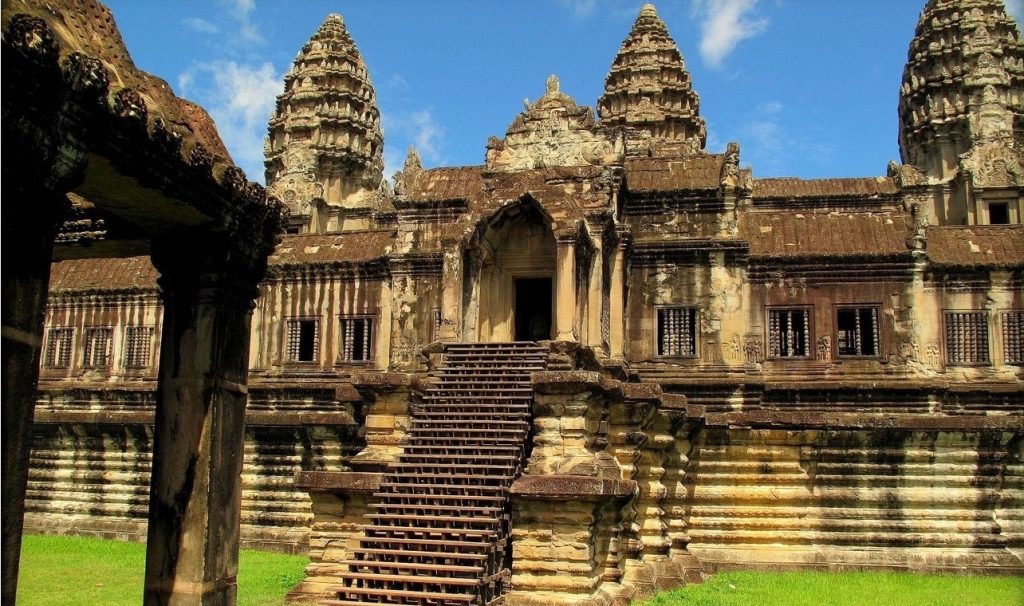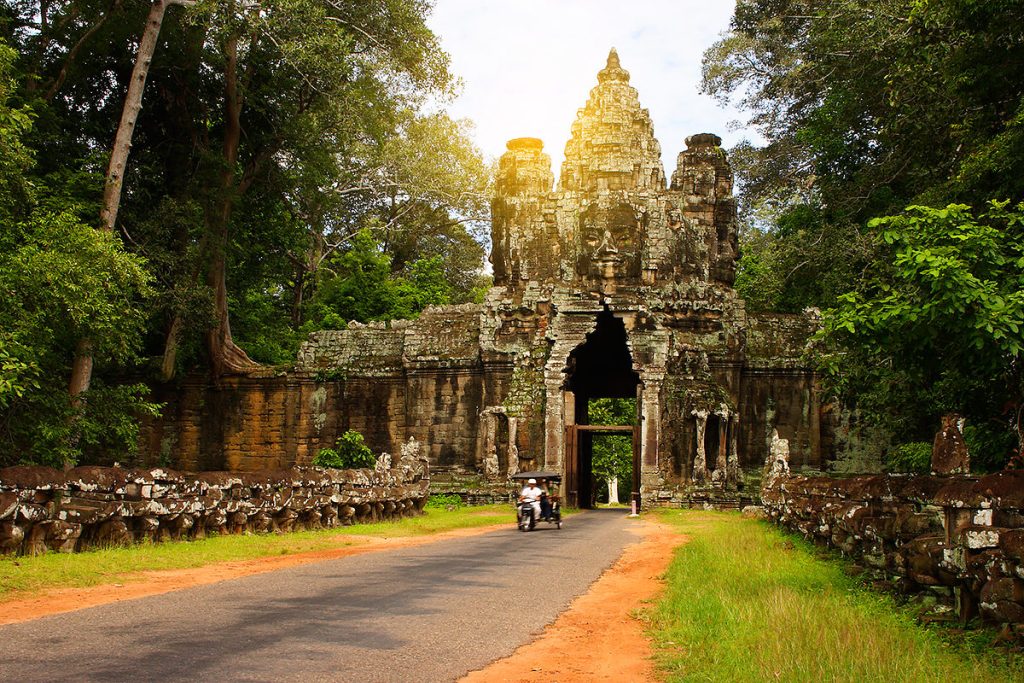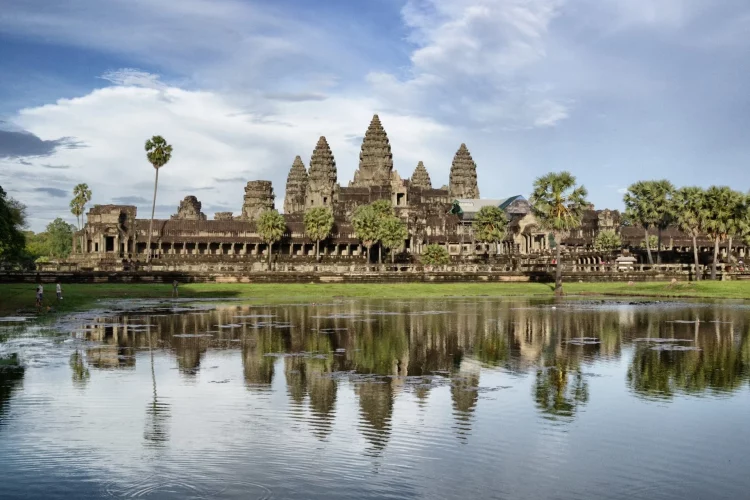Hidden in the rainforests of Southeast Asia is the site of a stunning ancient city, Angkor in Cambodia. Once the glorious capital of the Khmer Kingdom, this monument has not only witnessed the brightest period in the history of Cambodia and even Southeast Asia, but also become a shining pearl in the world cultural Heritage. This paper will dig deep into the unique charm of Angkor in Cambodia from multiple dimensions such as historical background, cultural characteristics, architectural style and social influence, and show its unique position and role in the global cultural heritage.
Historical background: A symphony of glory and decay
1.1 Establishment and prosperity of Angkor Dynasty
The history of Angkor in Cambodia dates back to 802 AD, when the Angkor Dynasty was founded by Jayavarman II, marking the beginning of one of the most glorious eras in Cambodian history. The Angkor Dynasty went through 34 generations of Kings for 628 years, and its influence reached its peak under Suyavarman II and Jayavarman VII. It covered all of present-day Cambodia, most of Thailand and Laos, and southern Vietnam, becoming one of the most powerful countries in the history of Southeast Asia.
During this period, the Angkor Dynasty was not only politically stable and economically prosperous, but also reached an unprecedented height in culture and art. The Kings built hundreds of temples and royal cities, the most famous of which is Angkor Wat, the largest temple-like structure in the world, which not only showcases the pinnacle of Khmer classical architecture, but also became an iconic symbol of Angkor civilization.
1.2 Decline and recovery
However, the good times did not last long, and with the invasion of the Thai and the turmoil within the dynasty, the Angkor dynasty gradually declined. In 1431, Angkor City was captured by the Siamese army, the king was forced to move the capital to Phnom Penh, Angkor City was gradually swallowed by the dense jungle, disappeared in the eyes of the world. It was not until the mid-19th century, when French naturalist Henri Mouhaux accidentally discovered the ruins of this magnificent ancient city in the virgin forest, that Angkor was rerevealed to the world and shocked the world.
Second, cultural characteristics: the artistic treasure of diverse integration
2.1 Religious belief and artistic expression
One of the major features of Angkor civilization is the diversity of its religious beliefs. In the early period of the Angkor Dynasty, the Khmer people mainly practiced Hinduism, but with the development of The Times, Mahayana Buddhism gradually spread in Cambodia and occupied an important position in Angkor civilization. This diversity of religious belief is vividly reflected in the architectural art of Angkor.

Angkor Wat, as a representative building of the Angkor civilization, was originally built to worship the Hindu god Vishnu, but over time, gradually evolved into a Buddhist temple. Its architectural style blends Hindu and Buddhist elements, including Hindu temples and pagodas, Buddhist statues and murals, demonstrating the unique artistic creativity and inclusiveness of the Khmer people.
2.2 The pinnacle of sculpture and mural art
Another notable feature of Angkor architecture is its superb sculpture and fresco art. The walls of temples such as Angkor Wat are covered with stunning reliefs and murals, intricate and realistic depictions of mythological, historical and religious scenes that demonstrate the rich imagination and artistic prowess of the Khmer people.
Particularly worth mentioning are the 49 huge four-sided Buddha statues in Bayon Temple, which are smiling, kind and solemn, known as the “Khmer smile”, and have become the symbol of Angkor civilization and even Cambodia. These statues not only show the Khmer people’s accurate grasp of facial expressions, but also convey their deep understanding of peace, tolerance and compassion.
Architectural style: Epic on stone
3.1 Magnificent architectural layout
The Angkor Monument Complex is located near Siem Reap, a city in northwestern Cambodia, covering an area of about 45 square kilometers, and the existing buildings mainly include more than 600 temples and palaces such as Angkor King City (Big Angkor) and Angkor Wat (Little Angkor). All built of stone, these buildings are large in scale and carefully laid out, demonstrating the remarkable architectural skills and extraordinary creativity of the Khmer people.
As the capital site of Angkor Dynasty, Angkor King City has strict layout and perfect function. There are many temple monuments in the city, covering a total area of about 9 square kilometers, and there is a moat protection on the outside. The Bayon Temple is the center of the city, forming a “cross” type structural axis, with a reasonable layout and well-scattered. Angkor Wat is famous for its unique square layout and multi-layer corridor structure. The lower corridor connects various Spaces, and the upper temple mountain forms a tower-like building layer by layer. The overall shape is magnificent and magnificent.
3.2 Exquisite architectural skills
The craftsmanship of Angkor architecture manifests itself in many ways. First of all, these buildings are all made of stone, which is not only durable but also beautiful. The mining, transportation and processing of stone require extremely high skills and a large amount of labor input, which fully demonstrates the superior labor skills and organizational capabilities of the Khmer people.
The art of carving and murals in Angkor architecture also reached its peak. The sculpting works have smooth lines and vivid shapes; The mural works with bright colors and clever composition fully demonstrate the outstanding artistic talent and profound cultural heritage of the Khmer people.
Angkor architecture also demonstrates the deep understanding and clever use of the natural environment by the Khmer people. For example, the moat around Angkor Wat not only serves as a defense but also regulates the city’s water system; The pool and fountain in the temple increase the flexibility and appreciation of the building. These designs reflect the harmonious coexistence of Khmer wisdom and nature.
Social impact: Cultural heritage in Southeast Asia and globally
4.1 Important source of Southeast Asian culture
Angkor civilization is not only the treasure of Cambodian culture but also one of the important sources of Southeast Asian culture. During the Angkor Dynasty, the cultural influence of the Khmer people spread far and wide and had a profound impact on the neighboring countries such as Champa, Laos and Siam. These countries have absorbed the essence of Khmer culture to varying degrees and integrated it into their own culture to form a unique Southeast Asian cultural circle.

4.2 Treasures of global cultural heritage
In 1992, UNESCO inscribed the Angkor monuments on the World Cultural Heritage List, marking the widespread recognition and praise of Angkor civilization on a global scale. As one of the seven wonders of the world, Angkor has not only attracted countless tourists to come for sightseeing, but also become an important object for scholars to study the history and culture of Southeast Asia.
The protection and restoration of Angkor monuments has also received extensive attention and support from the international community. Governments and international organizations have invested a lot of money and technical strength to carry out comprehensive protection and restoration of Angkor monuments so that they can be better preserved and passed on to future generations.
4.3 Promote the development of tourism in Cambodia
The discovery and preservation of Angkor has not only brought honor and reputation to Cambodia but also greatly promoted the development of the country’s tourism industry. With the increasing popularity of Angkor monuments, more and more tourists come here to promote the vigorous development of Cambodian tourism. Tourism has become one of the important pillars of the Cambodian economy, bringing considerable economic income and employment opportunities to the country.
Conclusion: Eternal charm of millennium civilization
As a cultural heritage treasure in Southeast Asia and even the world, Angkor in Cambodia shows the eternal charm of millennium civilization with its unique historical background, cultural characteristics, architectural style and social influence. It not only bears witness to the historical process of the Khmer kingdom’s glory and decline, but also inherits the essence and wisdom of Southeast Asian culture. In the coming years, Angkor monuments will continue to attract the attention of the world with its unique charm and become the common precious wealth of mankind.
By digging deeply into the historical background, cultural characteristics, architectural style and social influence of Angkor, we can not only better understand the unique charm of this millennium civilization, but also better inherit and carry forward the diversity and inclusiveness of human civilization. Let us cherish and protect this precious cultural heritage and let the glory of Angkor shine forever in the sky of human civilization.





















